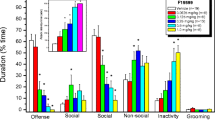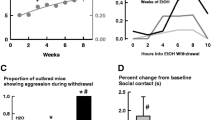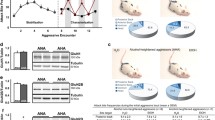Abstract.
Rationale: Zolmitriptan is an anti-migraine agent with action at 5-HT1B/D receptors. It penetrates into the central nervous system and, like other 5-HT1B/D agonists, its pharmacotherapeutic profile may include significant anti-aggressive effects. Objectives: To examine whether zolmitriptan has potential anti-aggressive effects by studying two kinds of aggressive behavior in mice – species-typical and aggression under the influence of alcohol. A second objective was to study whether pre- or post-synaptic receptors mediate these anti-aggressive effects. Methods: Initially, the anti-aggressive effects of zolmitriptan were studied in male CFW mice during 5-min resident–intruder confrontations. To confirm the 5-HT1B receptor as a critical site of action for the anti-aggressive effects, the zolmitriptan dose–effect determinations were repeated after pretreatment with GR 127935 (10 mg/kg, i.p.). In further experiments, mice were treated concurrently with alcohol (1.0 g/kg, p.o.) and zolmitriptan (1–30 mg/kg, i.p.) in order to compare the effects of this agonist on species-typical and alcohol-heightened aggression. Finally, mice were infused with the neurotoxin 5,7-DHT (10 µg) into the raphé area to eliminate somatodendritic and presynaptic autoreceptors. The anti-aggressive effects of zolmitriptan (17 mg/kg, i.p.) or CP-94,253 (10 mg/kg, i.p.) were assessed 10 days after the lesion, and levels of 5-HT and 5-HIAA were measured in the hippocampus and prefrontal cortex. Results: Zolmitriptan exerted behaviorally specific anti-aggressive effects. The reduction in aggression was antagonized by GR 127935, indicated by a rightward shift in the dose–effect curves of zolmitriptan, showing the specificity for the 5-HT1B receptors. Zolmitriptan also decreased alcohol-heightened aggression with equal efficacy. The anti-aggressive effects of CP-94,253 and zolmitriptan remained unaltered by 5,7-DHT lesions that depleted cortical and hippocampal 5-HT by 60–80%. Conclusions: Zolmitriptan proved to be an effective and behaviorally specific anti-aggressive agent in situations that engender moderate and alcohol-heightened levels of aggression. These effects are potentially due to activation of post-synaptic 5-HT1B/D receptors.
Similar content being viewed by others
Author information
Authors and Affiliations
Additional information
Electronic Publication
Rights and permissions
About this article
Cite this article
de Almeida, R.M., Nikulina, E.M., Faccidomo, S. et al. Zolmitriptan – a 5-HT1B/D agonist, alcohol, and aggression in mice. Psychopharmacology 157, 131–141 (2001). https://doi.org/10.1007/s002130100778
Received:
Accepted:
Issue Date:
DOI: https://doi.org/10.1007/s002130100778




